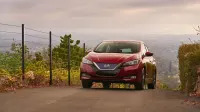U.S. finalizes long-delayed ‘quiet cars’ rule for EVs — and delays it again

WASHINGTON — The U.S. Department of Transportation on Monday finalized rules that will require “quiet cars” like electric vehicles and hybrids to emit alert sounds to warn pedestrians of their approach, extending to 2020 the deadline for full compliance.
The long-delayed rules, which were first demanded by Congress in 2010, will require automakers like Tesla, Nissan and General Motors to add sounds to vehicles when they are moving at speeds of up to 18.6 miles per hour (30 km per hour) to help prevent injuries among pedestrians, cyclists and the blind.
The regulation requires the sounds be added to all “quiet” vehicles by September 2020 — a year behind the schedule announced by the administration of former President Barack Obama in November 2016. Automakers must have the sounds in 50 percent of vehicles by September 2019.
To meet emissions requirements from California and other states, automakers need to sell more electrically powered vehicles, and those vehicles are often harder to hear at lower speeds than gasoline-powered engines.At higher speeds, tire noise, wind resistance, and other factors eliminate the need for a separate alert sound, regulators say.
The Trump administration froze the Obama-era rule as it conducted a review of petitions from automakers. Nissan had argued that the alert was only needed up to 12.4 mph (20 kph).
But that was rejected by the National Highway Traffic Safety Administration (NHTSA), an arm of the Department of Transportation, which has said it expects the rules finalized on Monday to prevent 2,400 injuries annually by 2020 and to require the addition of alert sounds to about 530,000 model 2020 vehicles.
Regulators said they will consider a request from automakers to allow them to include multiple sounds that would allow owners to select a preference.
NHTSA has said the rules will cost the auto industry about $40 million annually because automakers will need to add an external waterproof speaker to comply. But the benefits of the reduced injuries are estimated at $250 million to $320 million annually.
The agency estimates the odds of a hybrid vehicle being involved in a pedestrian crash are 19 percent higher than with a traditional gasoline-powered vehicle. About 125,000 pedestrians and cyclists are injured annually on roads in the United States.
“This rule strikes the right balance for automakers and for the blind community,” Gloria Bergquist, spokeswoman for car industry group the Alliance of Automobile Manufacturers, said on Monday.
Under a 2010 law passed by Congress, NHTSA initially was supposed to finalize the regulations by January 2014.
Reporting by David Shepardson
Related Video:




